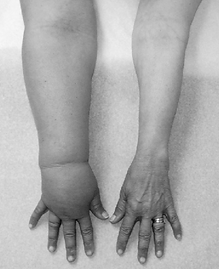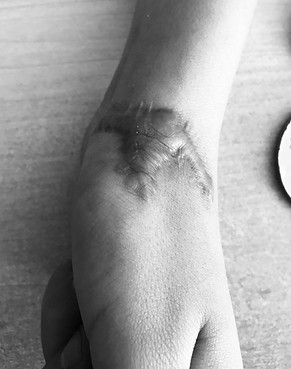
Our Services

Hand
Therapy
Our hands are our greatest tools in all areas of life! Hand injuries can be devastating in terms of function, earning an income, and severe physical and emotional pain.
We rehabilitate conditions such as arthritis, tendon and nerve injuries, carpal tunnel, bone fractures, amputations, pain and swelling throughout the arm and hand.
Custom made splints are fabricated for each patient according to the diagnosis and individuals needs
Scar
Management
Scars come in many shapes, colours and sizes, and can often cause limitations to mobility and function. Furthermore, they may have a psychological impact.
We assist in managing painful or sensitive scars, raised or thick scars, and scars that are causing dysfunction of the body. We work towards achieving smooth, soft and comfortable scars.
We manufacture and fit pressure garments measured for each individual patient.
Lymphoedema
Management
Lymphoedema is a type of persistent swelling in any part of the body caused by a dysfunction in the lymphatic system.
Our therapists are trained specifically in managing lymphoedema to reduce and control the swelling, allowing better comfort, confidence and capability in daily activities.
Therapy commonly consists of manual lymphatic drainage, compression, exercise and skin care.
Hand Therapy

Hand therapy is the art and science of rehabilitation of the upper limb - from the shoulder to the hand. Hand therapy assists a person to regain maximum use of his or her upper limb after injury, surgery or the onset of disease.
- South African Society of Hand Therapists
Our therapists all have a special interest and experience in the rehabilitation of hand & upper limb conditions. Passion and love for hand therapy as well as keeping updated in the most recent protocols and techniques drive us to provide the best possible therapy during each session.
As hand therapists, we treat using different exercises and activities, and apply a variety of treatment modalities. We fabricate custom made splints according to each patients specific needs to help the hand heal, assist in returning function, and protect it from additional injury.
Treatment may be conservative (i.e. treatment not involving surgery), in preparation for an upcoming surgery, or post-operative rehabilitation.
We see a large variety of conditions and injuries, with treatment sessions tailored to each individuals needs and goals.
Commonly treated conditions/injuries include:
-
Bone fractures
-
Arthritis
-
Stiffness
-
Sprains and strains
-
Joint injury
-
Tendon injury
-
Nerve Injury
-
Carpal Tunnel
-
Repetitive strain injury
-
Burns
-
Crush injury
-
Amputation
-
Swelling
-
Pain
As Occupational Therapists, our therapy emphasises the reintegration into the work place, activities of daily living and leisure activities. This may be through working towards improving hand function, compensating for a permanent loss of function, or adapting a task or environment to allow appropriate and independent engagement in meaningful activities.

Scar
Management
Scar formation is a normal response following any injury or surgery; it is the way the body heals injured structures. Scar tissue may involve only the superficial skin, or it may involve the deeper tissues beneath the skin, including nerves and tendons.
- American Society for Surgery of the Hand
Scars come in all sorts of shapes and sizes. Scars can be a result of a burn, injury or surgical incision. Everybody heals and scars differently, and different methods may be used on different types of scars. Hypertrophic scars (thickened and raised scars) and Keloid scars (growing outside the scar boundaries) are often a concern to a patient.
Scars can change in feel and appearance as they mature, which can take up to 2 years. We therefore can impact and make changes to a scar within this period of time. Initially, scars are often overly sensitive, raised, firm and thick, resulting in functional and mobility limitations and well as poor psychological and self-esteem effects.
Scar management includes the use of a variety of techniques and modalities with the aim of achieving soft, smooth, flexible scars that do not limit your ability to move and function. Scars can form anywhere on the body, therefore our therapists are trained to treat scars no matter their location on the human body.
Timing of scar management varies depending of the type of scar, healing of wounds and infection and stitch removal. These factors can be monitored and facilitated by our therapists.
Scar management treatments may include:
-
Scar massage and moisturisation
-
Desensitisation
-
Cupping
-
Silicone application
-
Exercise
-
Pressure garments
Pressure garments are frequently prescribed for burn scars that have become hypertrophic (thickened and raised) or any other hypertrophic scars caused by skin grafts or surgical incisions.
Hypertrophic scars can easily limit the movement of a joint as they shorten and contract, therefore it is important to manage these scars to improve mobility and function, as well as prevent future deformity.
A pressure garment helps improve the appearance and pliability of a scar, assisting in giving a patient more confidence and allowing for more freedom of movement.
Our therapists custom make pressure garments for each patient and their individual needs. The garment is a tight fitting elastonet garment that applies pressure to the scar. The pressure applied flattens the scar and changes the appearance in terms of the scar thickness and colouring.
Pressure garments are worn 23 hours a day for a period of up to 2 years while the scars are remodelling. During this period, your therapist will teach you how to care for your scars and garments, and can adjust your pressure garments to ensure a good fit constantly. New pressure garments may need to be issued due to wear and tear.
Lymphoedema
Management
_edited_edited.jpg)
Lymphoedema is an abnormal, long-term swelling of part/s of the body caused by a collection of lymphatic fluid (including water and proteins) in the tissues below the skin. It occurs when there is a dysfunction in the lymphatic system.
Lymphoedema is most commonly seen in one or both arms or legs, but may present in the face, body and genitals. It is a persistent swelling that may range from a mild increase in size of the limb/area to a grossly swollen limb with changes to the quality of the skin. Severe cases of lymphoedema can be debilitiating. Lymphoedema is sometimes, but not always painful.
- Lymphoedema Association of South Africa
Signs and symptoms of lymphoedema commonly increase gradually and become more noticable and limiting with time. If managed in the early stages, lymphoedema can be controlled quickly before it is reaches a debilitating stage.
Signs and symptoms of lymphoedema include:
-
Mild to severe discomfort of the affected body part
-
Pain is unusual but can occur in certain secondary lymphoedema’s
-
Feeling of “heaviness” or “fullness” in the affected body part
-
Increased size of the affected limb/body part
-
Skin changes (such as discolouration, thickening of the skin)
-
Sometimes there can be restricted movement in the affect limb
-
Frequent infections of the skin are common
There are many causes of lymphoedema. Some are primary, meaning that an individual is born with a certain defect in their lymphatic system. This can lead to a build-up of fluid in certain parts of the body. This swelling may be noticed since birth, or could possibly only present later on in life.
Secondary causes can be due to a number of reasons:, and may lead to a progressive, chronic overload of the lymphatic system causing swelling
-
Venous insufficiency
-
Trauma
-
Infection
-
Surgery
-
Immobility
-
Cancer
-
Surgical removal of lymph nodes
-
Post mastectomy
Lymphoedema cannot be cured but can be effectively managed with therapy. The process of treating lymphoedema is known as complete decongestive therapy (CDT). This includes:
-
Detailed evaluation
-
Patient and family education
-
Manual lymph drainage (MLD)
-
Compression
-
Skin Care
-
Home exercises
Natalie Powell and Jessica Dent are both trained and qualified
in the management of lymphoedema. Treatment is individualised
for each patients needs in order to achieve the best possible
outcome and reach patient goals.
Lymphoedema is a chronic condition with no cure, but with the
right techniques it can be prevented, managed and maintained.
Your life does not need to be limited by your lymphoedema.






_edited.jpg)